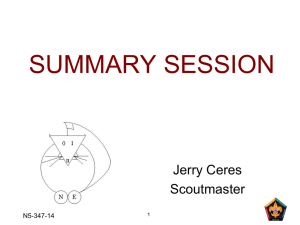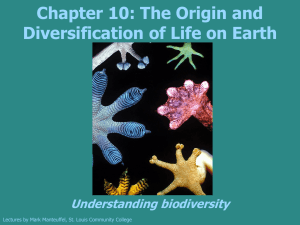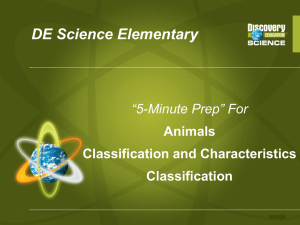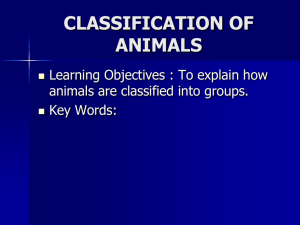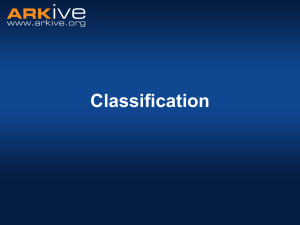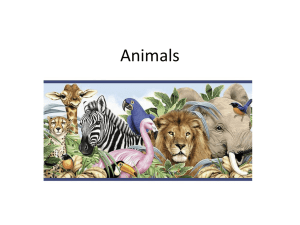- faculty lounge: non
advertisement
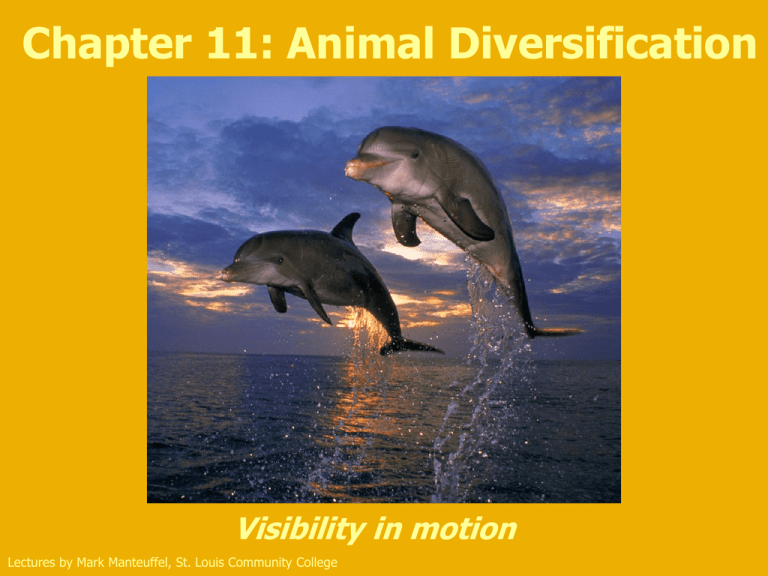
Chapter 11: Animal Diversification Visibility in motion Lectures by Mark Manteuffel, St. Louis Community College Learning Goals Define an animal and the key distinctions that divide the species. Discuss evolutionary success. Define and describe vertebrates and their evolution. Define and describe the terrestrial vertebrates, including amphibians, birds, and mammals. Learning Goals Describe early human lifestyles and human evolution. Define and describe the invertebrates, including echinoderms, arthropods, molluscs, annelids, flatworms, cnidarians, and sponges. Are some animals smarter than others? 11.1 What is an animal? Three Key Characteristics Take-home message 11.1 Animals are organisms that share three characteristics: 1) All of them can move during at least one stage of development. 2) All of them eat other organisms. 3) All of them are multicellular. 11.2 Four key distinctions divide the animals. 1) Does the animal have defined tissues, with specialized cells? 2) Does the animal develop with radial symmetry or bilateral symmetry? A body structured like a pie or A body with a left and right side, which are mirror images 3) During development, does the animal’s gut develop from front to back or back to front? Protostomes and Deuterostomes 4) Does growth occur by molting or by adding continuously to the skeletal elements? Take-home message 11.2 The animals probably originated from an ancestral protist. Four key distinctions divide the extant animals: 1) 2) 3) 4) tissue or not radial or bilateral symmetry protostome or deuterostome development growth through molting or not 11.3 Everything that is not extinct is evolutionarily successful. What is “success” evolutionarily? Extant or Extinct Take-home message 11.3 From an evolutionary perspective, all extant species are successful. However, some groups are represented by more species than others. Among the 36 animal phyla, 9 phyla account for more than 96 percent of all described animal species. 11.4 All vertebrates are members of the phylum Chordata. Four distinct features of chordates The Notochord A rod of tissue extending from the head to the tail Stiffens the body when muscles contract during locomotion In advanced chordates • present only in early embryos • replaced by the vertebral column (backbone) A Dorsal Hollow Nerve Cord Extends from head to tail In vertebrates, forms the central nervous system (spinal cord and brain) In other animals, lies in lower portion of ventral part of body (and is solid instead of hollow) Pharyngeal Slits Pharyngeal region • the area between the back of the mouth and the top of the throat Pharyngeal slits are present in the embryos of all chordates. Originally used for breathing and feeding A Post-Anal Tail extends back beyond the end of the trunk The phylum Chordata contains three sub-phyla: The Most Diverse Subphylum of Chordates Take-home message 11.4 All chordates have four structures: 1) 2) 3) 4) a notochord a dorsal hollow nerve cord pharyngeal gills slits a post-anal tail Take-home message 11.4 The three subphyla of chordates are very different • but all possess these four characteristics, • although some reveal those characteristics only during specific life stages. 11.5 The evolution of jaws and fins gave rise to the vast diversity of vertebrate species. The evolution of fins paralleled the evolution of jaws because the two structures work together. Fins get you to the organism you are going to eat. Jaws capture and kill it. Take-home message 11.5 The development of two structures—fins and jaws—set the stage for the enormous diversity of modern vertebrates. 11.6 The movement onto land required lungs, a rigid backbone, four legs, and eggs that resist drying. Take-home message 11.6 In the transition of vertebrates from life in water to life on land: • fins were modified into limbs • vertebrae were modified to transmit the body weight through the limbs to the ground • the site of gas exchange was transferred from gills to lungs Take-home message 11.6 The only entirely new feature to appear in the early development of terrestrial vertebrates was an egg that resisted drying out. 11.7 Amphibians live a double life. Take-home message 11.7 Amphibians are terrestrial vertebrates (tetrapods), but most species still lay eggs in water and the eggs hatch into aquatic larvae (tadpoles). 11.8 Birds are reptiles in which feathers evolved. Feathers Take-home message 11.8 Birds The are a branch of the reptile lineage. complex systems that we see in living animals are the products of hundreds of millions of years of step-by-step changes that began with simple structures. Take-home message 11.8 The function of a structure when it first appeared was probably quite different from its current function. Feathers were originally colorful structures used for behavioral displays. Their current uses—as insulation and in flight— developed later. 11.9 Mammals are animals that have hair and produce milk. Are all mammals viviparous? Viviparity—giving than laying eggs Monotremes milk. birth to babies rather lay eggs, but also produce Take-home message 11.9 The presence of hair and lactation are defining characteristics of mammals. Take-home message 11.9 Monotremes are egg-laying mammals. Marsupial mammals have a pouch in which the baby completes its development. Placental mammals have a placenta that provides oxygen and nutrients to embryos. 11.10 Humans tried out different life styles. Chimpanzee and Modern Human Lineages Separated only 5 or 6 million years ago Humans differ from chimpanzees in three major anatomical characteristics: Humans are bipedal. Humans are bigger than chimpanzees. Humans have a brain that is about three times the size of the brain of a chimpanzee. What are the advantages of walking on two feet rather than four? Take-home message 11.10 Humans’ forward-looking eyes, hands and feet with ten fingers and ten toes, and shoulder and elbow joints that allow the arms to rotate are characteristics we retain from our arboreal ancestors. Take-home message 11.10 The early ancestors of humans, however, left the trees and took up life on the ground where they walked on two legs. Our success can be traced to an increase in brain size combined with a generalized body form and a diet that included both animals and plants. 11.11 How did we get here? The last 100,000 years of human evolution Were there ever two species of humans alive at the same time? What happened? Neandertals, Homo neanderthalensis About the same size as modern humans More robust and muscular Lived in organized groups Probably hunted large mammals The Indo-Australian Archipelago Homo erectus Homo floresiensis Take-home message 11.11 humans (Homo sapiens) evolved in Africa between 200,000 and 100,000 years ago, and all living humans are descended from that evolutionary radiation. Modern Take-home message 11.11 About 100,000 years ago a small group of modern humans moved out of Africa, and the descendants of this group ultimately populated Europe, Asia, and the Americas. Three other species of humans were living at this time. Take-home message 11.11 Other human species became extinct between 30,000 and 12,000 years ago, after modern humans had spread into the areas where they were living. 11.12 Invertebrates are the largest and most diverse group of animals. Take-home message 11.12 Invertebrates, defined as animals without a backbone, are the largest and most diverse group of animals, comprising 96% of all the living species of animals. The invertebrates are not a monophyletic group, however, and include protostomes and deuterostomes. 11.13 Echinoderms are vertebrates' invertebrate relatives Sea stars, sea urchins, and sand dollars Evolutionary Specialization Radial An symmetry in adults evolutionary specialization associated with their locomotor mode and feeding specializations Echinoderms and Chordates Bilateral symmetry in larvae The larvae have anatomical characteristics in common with the larvae of primitive chordates. Echinoderms and chordates are each other’s closest relatives. Take-home message 11.13 Echinoderms are deuterostomes like chordates, but they lack backbones. Their aquatic larvae are bilateral and share some anatomical features with chordates, but adult echinoderms are radially symmetrical. 11.14 An external skeleton and metamorphosis produced the greatest adaptive radiation ever. Mammals get bigger and bigger the more they eat. Why don’t insects? Take-home message 11.14 The arthropods are protostome invertebrates, including the insects. The life cycle of most insects includes a larval stage, which is devoted to feeding and growth, and an adult stage, in which the insect reproduces. Take-home message 11.14 This separation of life stages has contributed to the enormous ecological diversity of insects. It has also produced remarkable specializations among the nearly 1 million species of insects that have been named. 11.15. Other arthropods include arachnids, crustaceans, millipedes, and centipedes. Arachnids Land-dwelling arthropods Include spiders, scorpions, mites, and ticks Usually have four pairs of walking legs • and a specialized feeding apparatus Only have legs on the thorax Spider Venom Arachnids Black are predators widow spider Brown recluse spider Scorpions Being stung by most scorpions is no worse than being stung by a bee Nocturnal predators of insects The Crustaceans • Lobsters, crayfish, crabs, and shrimps • All have five pairs of appendages extending from their heads • Many pairs of legs modified for many purposes • Most are aquatic Millipedes and Centipedes • “A thousand feet” and “a hundred feet” • Long segmented bodies • Millipedes feed on decaying plant material • Centipedes are predators—use venomous fangs to kill insects and even small mammals Take-home message 11.15 Spiders and scorpions are arthropods that eat insects and occasionally small vertebrates. Lobsters, crabs, shrimps, and barnacles are predatory marine crustaceans. Centipedes are predators with fangs that inject venom, while millipedes are herbivores that feed on dead plant material. 11.16 Most molluscs live in shells. The Three Major Groups of Mulluscs 1) Gastropods 2) Bivalve molluscs 3) Cephalopods Gastropods Snails and slugs are called gastropod molluscs. “Belly Found foot” in both aquatic and terrestrial environments, snails and slugs account for three-quarters of all molluscs. Bivalve Molluscs Clams, scallops, oysters, and mussels have a pair of shells that clamp together. Roughly 8000 species of bivalve—most of them live in the ocean. All are filter feeders. Cephalopods Take-home message 11.16 Molluscs are protostome invertebrates that do not molt. Including the snails and slugs, clams and oysters, and squid and octopuses, the molluscs are the second most diverse phylum of animals. Take-home message 11.16 Most feature a shell for protection, a mantle of tissue that wraps around their body, and a specialized tongue called a radula. 11.17 Are some animals smarter than others? Are octopuses smart? Take-home message 11.17 The predatory behavior of octopuses involves exploration and manipulation These behaviors are considered as intelligent by humans, but the concept of intelligence cannot be applied objectively to other species. Rather, species should be viewed as having evolved in response to the selective forces relevant only to their own particular environments. 11.18 Segmented worms, flatworms, and roundworms come in all shapes and sizes. Polychaetes Marine worms “Many bristles” Some are burrowing Some are tube dwelling Earthworms “Few Bulk bristles” feeders • consume particles of soil and organic material Castings are valued by gardeners Leeches The saliva of blood-sucking leeches contains an anticoagulant substance that prevents blood from clotting. Not all leeches are blood suckers. • More than half the species of leeches are predators. Roundworms Take-home message 11.18 Worms fall into several different phyla and are not a monophyletic group. All are bilaterally symmetrical protostomes with defined tissue. The segmented worms (annelids) and flatworms do not molt, whereas the roundworms do. Take-home message 11.18 Earthworms play an important role in recycling dead plant material. Roundworms are often parasites of plants or animals and are responsible for several widespread human diseases. Flatworms include parasitic flukes and tapeworms, many of which infect humans. 11.19 Jellyfish and other cnidarians are among the most poisonous animals in the world. Cnidarians Two types of cnidarian bodies: • a sessile polyp • a free-floating medusa. Reproduce both sexually and asexually Carnivores that use cnidocysts • stinging cells Although all cnidarians possess cnidocytes, there is great diversity among the three major groups. Jellyfish Sea anemones Corals How is global warming affecting the coral reefs of the world? Take-home message 11.19 Jellyfish, sea anemones, and corals are radially symmetrical animals with defined tissue, from the phylum Cnidaria. All cnidarians are carnivores and possess specialized stinging cells located in tentacles to capture prey. 11.20 Sponges are animals that lack tissues and organs. Take-home message 11.20 Sponges are among the simplest of the lineages of animals. A sponge consists of a hollow tube with pores in its wall, it has no tissues or organs, and only three kinds of cells. Take-home message 11.20 Sponges reproduce asexually (by budding) and sexually by producing eggs and sperm. The fertilized eggs grow into freeswimming larvae that settle and metamorphose into sessile adult sponges.


